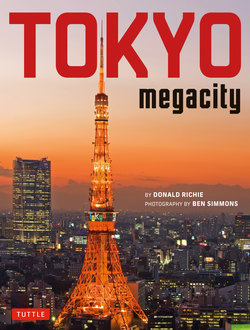Читать книгу Tokyo Megacity - Donald Richie - Страница 10
На сайте Литреса книга снята с продажи.
ОглавлениеThe Imperial Palace
A stone bench makes a great spot to stop and admire the inner moat and waterfowl near the Imperial Palace’s Sakuradamon Gate.
In the middle of the vast city of Tokyo lies the Imperial Palace, the castle grounds surrounded by its walls, moats, gates. It is the official residence of the Japanese Imperial family and even has a mailing address (1, 1-1, Chiyoda, Chiyoda-ku, Tokyo), yet its grounds also contain presumably primeval forests.
It has been compared to New York’s Central Park and has been called the most expensive property in the world, its worth having been estimated as equivalent to the value of all the real estate in California.
It also constitutes one of the major obstacles to Tokyo traffic, trains, subways, trucks and cars, all these having to make long, crowded detours around it. But no one complains and no one is allowed in, though the pedestrian public can venture onto the inner palace grounds twice a year (January 2 and December 23) to give, respectively, New Year’s greetings and best wishes on His Imperial Highness’s birthday.
Otherwise, the visitor must be content with the single “view”— Nijubashi, a bridge backed by the Fushimi Tower, one of the few original buildings (first half of the 17th century), a view captured on the first Tokyo picture postcard ever printed, and seen on most ever since.
Because Tokyo was from the first a planned military capital, the palace and its grounds have always constituted something of a Forbidden City. The last and largest of Japanese castles, Edo’s towered over the Musashino plain, but did not last long. The main castle keep was destroyed by fire in 1657 and other parts of the castle have been burned a number of times—from the insurrections of 1868 to the U.S. fire bombings of Tokyo in 1945.
Otherwise, all that is left are a number of place names derived from where the enormous castle stood. Takebashi (Bamboo Bridge) where the Tokyo Museum of Modern Art presently resides, Toranomon (Tiger Gate) now a part of Mid City Tokyo, and the Marunouchi district, facing Tokyo Station. It is from this center then that the city spread.
Dawn’s first light warmly illuminates the Palace’s Nijubashi Bridge, overlooked by the Fushimi Yagura Watchtower, a surviving remnant of Edo Castle.
A stone lion, or shishi, stands guard outside the outer defensive walls of the Imperial Palace. Tra – dition dictates that a pair of shishi, one male and the other female, guard the entrances of buildings of importance, such as many temples and shrines.
The massive wooden gate at Yasukuni Shrine dwarfs a young boy in formal kimono.
An imperial watchtower contrasts with a modern office building.
A petite kimono-clad visitor feeds the white pigeons at Yasukuni Shrine.
A white swan glides through the famous “double bridge” refection of Nijubashi Bridge.
The statue of Ota Dokan, the samurai architect who designed and built Edo Castle in 1457, faces the Imperial Palace from inside the modern laminated-glass and steel structure of the Tokyo International Forum.
Rowboats await punters visiting the Chidorigafuchi Moat at the Imperial Palace.
People take boats out in Chidorigafuchi, the northeastern moat of the Imperial Palace, to enjoy a bit of respite in the otherwise bustling heart of the city. April, when the stately cherry trees (sakura) are in full bloom, is a particularly popular time for such outings.
Sakurada-mon is an outer gate of the Imperial Palace. Access to the Imperial Palace’s inner grounds occurs on only two days each year.
